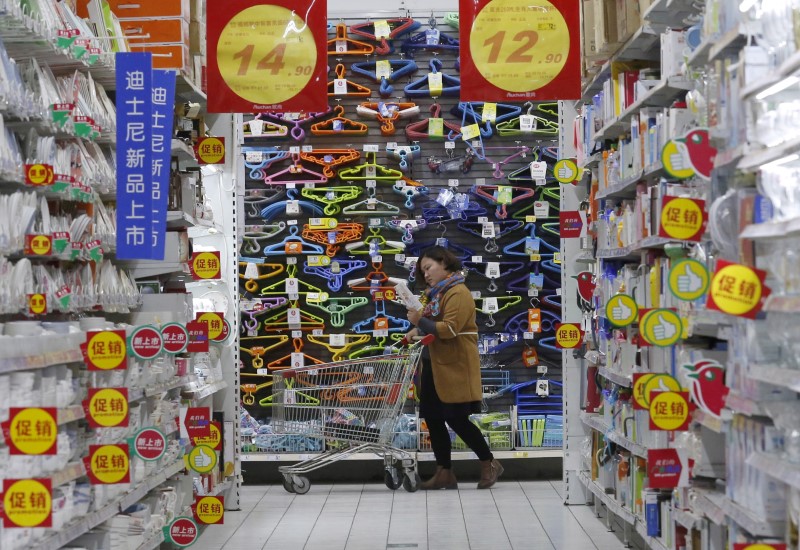
FILE PHOTO: A customer pushes a shopping cart at Sun Art Retail Group’s Auchan hypermarket store in Beijing, China, November 9, 2015. REUTERS/Kim Kyung-Hoon/File Photo
May 10, 2018
By Stella Qiu and Kevin Yao
BEIJING (Reuters) – China’s producer inflation picked up for the first time in seven months in April, bolstered by surging commodities prices and suggesting its industrial demand remains resilient even as trade tensions ratchet up with the United States.
But consumer inflation eased from the previous month as food prices rose at a slower pace, official data showed on Thursday.
Analysts and investors are closely watching inflation gauges in China for signs of a long-expected economic slowdown that would weigh on industrial profit growth and investment and possibly tip a shift in central bank policy.
But the country’s commodity futures markets are notoriously speculative, making it difficult to tell if producer price swings are pointing to a real change in underlying demand.
The producer price index (PPI) rose 3.4 percent in April from a year ago, accelerating from a 17-month low of 3.1 percent in March, the National Bureau of Statistics (NBS) said on Thursday. On a month-on-month basis, it declined 0.2 percent.
Analysts polled by Reuters had expected producer inflation would rebound to 3.5 percent as steel mills stocked up on raw materials such as iron ore and coking coal to meet a seasonal surge in construction. Oil prices have also been on the rise.
Sharper factory-gate price rises could bolster profits for industrial firms, which saw earnings growth slow to the weakest pace in over a year in March.
CONSUMER INFLATION EASES
The consumer price index (CPI) rose 1.8 percent from a year earlier, just below expectations and slowing from March’s 2.1 percent. On a month-on-month basis, it dipped 0.2 percent.
The core consumer price index, which strips out volatile food and energy prices, rose 2.0 percent in April, unchanged from March.
The food price index rose 0.7 percent on-year, after rising 2.1 percent in March, as distortions from the long Lunar New Year holiday receded. Non-food prices rose 2.1 percent, the same pace as the previous month.
Pork prices in April declined 16.1 percent on-year, most likely due to a glut in the market.
“The decline in pork prices in April dragged the headline number lower by 0.4 percentages points,” said David Qu, a Shanghai-based economist at ANZ. “But I don’t think the softness in pork prices is sustainable. We will most likely see a rebound sometime in the second half this year.”
TRADE WAR A RISK TO INFLATION
While neither Washington nor Beijing has set a hard timeframe for the imposition of tit-for-tat tariffs, there are worries that the threat of disruptions and higher costs could start to add upward pressure on inflation in China that would be felt from factory floors to farms.
Pork prices, for example, which have a large weighting in the consumer inflation basket, could soar if feed costs continue to rise. China imposed a hefty duty on imports of U.S. sorghum last month and has threatened high tariffs on U.S. soybeans.
But analysts still expect broader price pressures will moderate this year as higher borrowing costs and a cooling property market lead to a softening in economic activity.
China has set an inflation goal of 3 percent for 2018, the same target as last year. Most market watchers expect full-year CPI to be in the low- to mid-2 percent range, picking up from 2017 but still well within the central bank’s comfort zone.
Mild inflationary pressures had been expected to give Chinese policymakers plenty of room to continue their crackdown on riskier lending this year, which has been pushing up companies’ financing costs.
But China’s central bank last month cut reserve requirement ratios (RRR) for most banks, sparking fears that economic momentum may already be starting to slow.
That has prompted speculation that China is considering shifting monetary policy from a slightly tighter bias to a somewhat looser stance, as the threat of a trade war with the United States adds to the risks facing the world’s second-largest economy in coming months.
“Today’s inflation data point to easing price pressures, consistent with our view that inflation is already past its peak for the current economic cycle,” Julian Evans-Pritchard, senior China Economist at Capital Economics, wrote in a note after the data.
“Softening price pressures should give the People’s Bank ample room to loosen monetary policy later this year in response to cooling economic activity.”
Despite a stronger-than-expected first quarter, economists polled by Reuters still expect China’s economic growth to cool to 6.5 percent this year from 6.9 percent in 2017.
(Reporting by Lusha Zhang, Stella Qiu and Kevin Yao; Editing by Kim Coghill)

